Multiscale Computational and Pharmacophore-Based Screening of ALK Inhibitors with Experimental Validation
Abstract
1. Introduction
2. Results
2.1. Pharmacophore Modeling Results
2.2. Optimal Pharmacophore Model Validation Results
2.3. Screening Results Based on the Optimal Pharmacophore Model
2.4. PAINS Filtering and ADMET Prediction Results
2.5. Activity Validation Results
2.6. Molecular Docking Results
2.7. Molecular Dynamics Simulation Results
3. Discussion
4. Materials and Methods
4.1. Database Selection and Ligand Conformation Optimization
4.2. Pharmacophore Modeling
4.3. Pharmacophore Model Validation
4.4. PAINS Filtering and ADMET Prediction
4.5. Molecular Docking
4.6. Activity Validation
4.7. Molecular Dynamics Simulation
5. Conclusions
Supplementary Materials
Author Contributions
Funding
Institutional Review Board Statement
Informed Consent Statement
Data Availability Statement
Acknowledgments
Conflicts of Interest
References
- Ye, W.; Ou, W.B. Genomic landscaping of receptor tyrosine kinase ALK with highly frequent rearrangements in cancers. IUBMB Life 2025, 77, e70003. [Google Scholar] [CrossRef]
- Zhang, Y.-K.; Tong, J.-B.; Luo, M.-X.; Xing, X.-Y.; Yang, Y.-L.; Qing, Z.-P.; Chang, Z.-L.; Zeng, Y.-R. Design and evaluation of piperidine carboxamide derivatives as potent ALK inhibitors through 3D-QSAR modeling, artificial neural network and computational analysis. Arab. J. Chem. 2024, 17, 105863. [Google Scholar] [CrossRef]
- James, N.; Ramanathan, K. Discovery of Potent ALK Inhibitors Using Pharmacophore-Informatics Strategy. Cell Biochem. Biophys. 2018, 76, 111–124. [Google Scholar] [CrossRef] [PubMed]
- Ducray, S.P.; Natarajan, K.; Garland, G.D.; Turner, S.D.; Egger, G. The Transcriptional Roles of ALK Fusion Proteins in Tumorigenesis. Cancers 2019, 11, 1074. [Google Scholar] [CrossRef]
- Guan, J.; Borenas, M.; Xiong, J.; Lai, W.Y.; Palmer, R.H.; Hallberg, B. IGF1R Contributes to Cell Proliferation in ALK-Mutated Neuroblastoma with Preference for Activating the PI3K-AKT Signaling Pathway. Cancers 2023, 15, 4252. [Google Scholar] [CrossRef]
- Chen, J.; Zhang, Y.; Petrus, M.N.; Xiao, W.; Nicolae, A.; Raffeld, M.; Pittaluga, S.; Bamford, R.N.; Nakagawa, M.; Ouyang, S.T.; et al. Cytokine receptor signaling is required for the survival of ALK-anaplastic large cell lymphoma, even in the presence of JAK1/STAT3 mutations. Proc. Natl. Acad. Sci. USA 2017, 114, 3975–3980. [Google Scholar] [CrossRef]
- Zito Marino, F.; Rocco, G.; Morabito, A.; Mignogna, C.; Intartaglia, M.; Liguori, G.; Botti, G.; Franco, R. A new look at the ALK gene in cancer: Copy number gain and amplification. Expert. Rev. Anticancer. Ther. 2016, 16, 493–502. [Google Scholar] [CrossRef]
- Mohamad, N.; Jayalakshmi, P.; Rhodes, A.; Liam, C.K.; Tan, J.L.; Yousoof, S.; Rajadurai, P. Anaplastic lymphoma kinase (ALK) mutations in patients with adenocarcinoma of the lung. Br. J. Biomed. Sci. 2017, 74, 176–180. [Google Scholar] [CrossRef]
- Lin, Y.T.; Yu, C.J.; Yang, J.C.; Shih, J.Y. Anaplastic Lymphoma Kinase (ALK) Kinase Domain Mutation Following ALK Inhibitor(s) Failure in Advanced ALK Positive Non-Small-Cell Lung Cancer: Analysis and Literature Review. Clin. Lung Cancer 2016, 17, e77–e94. [Google Scholar] [CrossRef]
- Roskoski, R., Jr. Anaplastic lymphoma kinase (ALK) inhibitors in the treatment of ALK-driven lung cancers. Pharmacol. Res. 2017, 117, 343–356. [Google Scholar] [CrossRef]
- Rocco, D.; Battiloro, C.; Della Gravara, L.; Gridelli, C. Safety and Tolerability of Anaplastic Lymphoma Kinase Inhibitors in Non-Small-Cell Lung Cancer. Drug Saf. 2019, 42, 199–209. [Google Scholar] [CrossRef]
- Huang, M.; Fang, W.; Farrel, A.; Li, L.; Chronopoulos, A.; Nasholm, N.; Cheng, B.; Zheng, T.; Yoda, H.; Barata, M.J.; et al. ALK upregulates POSTN and WNT signaling to drive neuroblastoma. Cell Rep. 2024, 43, 113927. [Google Scholar] [CrossRef]
- Rothenstein, J.M.; Chooback, N. ALK inhibitors, resistance development, clinical trials. Curr. Oncol. 2018, 25, S59–S67. [Google Scholar] [CrossRef]
- Nagasundaram, N.; Wilson Alphonse, C.R.; Samuel Gnana, P.V.; Rajaretinam, R.K. Molecular Dynamics Validation of Crizotinib Resistance to ALK Mutations (L1196M and G1269A) and Identification of Specific Inhibitors. J. Cell Biochem. 2017, 118, 3462–3471. [Google Scholar] [CrossRef]
- Geng, K.; Xia, Z.; Ji, Y.; Zhang, R.R.; Sun, D.; Ai, J.; Song, Z.; Geng, M.; Zhang, A. Discovery of 2,4-diarylaminopyrimidines bearing a resorcinol motif as novel ALK inhibitors to overcome the G1202R resistant mutation. Eur. J. Med. Chem. 2018, 144, 386–397. [Google Scholar] [CrossRef] [PubMed]
- Zhang, X.; Tong, J.; Wang, T.; Wang, Z.; Gu, S.; Xu, L.; Hou, T.; Pan, P. In-depth theoretical modeling to explore the mechanism of TPX-0131 overcoming lorlatinib resistance to ALK(L1196M/G1202R) mutation. Comput. Biol. Med. 2024, 183, 109265. [Google Scholar] [CrossRef] [PubMed]
- Zhang, X.; Tong, J.; Wang, T.; Wang, T.; Xu, L.; Wang, Z.; Hou, T.; Pan, P. Dissecting the role of ALK double mutations in drug resistance to lorlatinib with in-depth theoretical modeling and analysis. Comput. Biol. Med. 2024, 169, 107815. [Google Scholar] [CrossRef] [PubMed]
- Singh, A.; Chen, H. Optimal Care for Patients with Anaplastic Lymphoma Kinase (ALK)-Positive Non-Small Cell Lung Cancer: A Review on the Role and Utility of ALK Inhibitors. Cancer Manag. Res. 2020, 12, 6615–6628. [Google Scholar] [CrossRef]
- Haratake, N.; Toyokawa, G.; Seto, T.; Tagawa, T.; Okamoto, T.; Yamazaki, K.; Takeo, S.; Mori, M. The mechanisms of resistance to second- and third-generation ALK inhibitors and strategies to overcome such resistance. Expert. Rev. Anticancer Ther. 2021, 21, 975–988. [Google Scholar] [CrossRef]
- Zhao, L.; Ciallella, H.L.; Aleksunes, L.M.; Zhu, H. Advancing computer-aided drug discovery (CADD) by big data and data-driven machine learning modeling. Drug Discov. Today 2020, 25, 1624–1638. [Google Scholar] [CrossRef]
- Zhang, Y.K.; Tong, J.B.; Luo, M.X.; Zhao, J.Y.; Yang, Y.L.; Sun, Y.; Qing, Z.P. Identification, experimental validation, and computational evaluation of potential ALK inhibitors through hierarchical virtual screening. SAR QSAR Environ. Res. 2025, 36, 271–285. [Google Scholar] [CrossRef] [PubMed]
- Alp, M.; Misturini, A.; Sastre, G.; Gálvez-Llompart, M. Drug screening of α-amylase inhibitors as candidates for treating diabetes. J. Cell. Mol. Med. 2023, 27, 2249–2260. [Google Scholar] [CrossRef] [PubMed]
- James, N.; Shanthi, V.; Ramanathan, K. Drug Design for ALK-Positive NSCLC: An Integrated Pharmacophore-Based 3D QSAR and Virtual Screening Strategy. Appl. Biochem. Biotechnol. 2018, 185, 289–315. [Google Scholar] [CrossRef] [PubMed]
- Cleves, A.E.; Jain, A.N. ForceGen 3D structure and conformer generation: From small lead-like molecules to macrocyclic drugs. J. Comput. Aided Mol. Des. 2017, 31, 419–439. [Google Scholar] [CrossRef]
- Al-Barghouthy, E.Y.; Abuhammad, A.; Taha, M.O. QSAR-guided pharmacophore modeling and subsequent virtual screening identify novel TYK2 inhibitor. Med. Chem. Res. 2019, 28, 1368–1387. [Google Scholar] [CrossRef]
- Luo, L.; Zhong, A.; Wang, Q.; Zheng, T. Structure-Based Pharmacophore Modeling, Virtual Screening, Molecular Docking, ADMET, and Molecular Dynamics (MD) Simulation of Potential Inhibitors of PD-L1 from the Library of Marine Natural Products. Mar. Drugs 2021, 20, 29. [Google Scholar] [CrossRef]
- Gehlot, P.; Kumar, S.; Kumar, V.; Vyas, V.K. Discovery of Thiadiazoles as Human Dihydroorotate Dehydrogenase (hDHODH) Inhibitors by Combined Structure-Based Modelling Methods. ChemistrySelect 2024, 9, e202304077. [Google Scholar] [CrossRef]
- El-Jundi, I.; Daoud, S.; Taha, M.O. Discovery of novel chemotype inhibitors targeting Anaplastic Lymphoma Kinase receptor through ligand-based pharmacophore modelling. SAR QSAR Environ. Res. 2024, 35, 795–815. [Google Scholar] [CrossRef]
- Chakravorty, S.J.; Chan, J.; Greenwood, M.N.; Popa-Burke, I.; Remlinger, K.S.; Pickett, S.D.; Green, D.V.S.; Fillmore, M.C.; Dean, T.W.; Luengo, J.I.; et al. Nuisance Compounds, PAINS Filters, and Dark Chemical Matter in the GSK HTS Collection. SLAS Discov. 2018, 23, 532–545. [Google Scholar] [CrossRef]
- Rashid, M.; Sajjad, N.; Shafiq, N.; Parveen, S.; Chaudhry, E.; Khan, R.A.; Badhe, P.; Al Mughram, M.H.; Dauelbait, M.; Bourhia, M. Unveiling Calotropis procera’s promising wound healing secrets by QSAR, molecular docking, DFT and ADMET profiling. Sci. Rep. 2025, 15, 21760. [Google Scholar] [CrossRef]
- Huang, W.S.; Liu, S.; Zou, D.; Thomas, M.; Wang, Y.; Zhou, T.; Romero, J.; Kohlmann, A.; Li, F.; Qi, J.; et al. Discovery of Brigatinib (AP26113), a Phosphine Oxide-Containing, Potent, Orally Active Inhibitor of Anaplastic Lymphoma Kinase. J. Med. Chem. 2016, 59, 4948–4964. [Google Scholar] [CrossRef] [PubMed]
- Huang, Q.; Johnson, T.W.; Bailey, S.; Brooun, A.; Bunker, K.D.; Burke, B.J.; Collins, M.R.; Cook, A.S.; Cui, J.J.; Dack, K.N.; et al. Design of potent and selective inhibitors to overcome clinical anaplastic lymphoma kinase mutations resistant to crizotinib. J. Med. Chem. 2014, 57, 1170–1187. [Google Scholar] [CrossRef] [PubMed]
- Kong, X.; Pan, P.; Sun, H.; Xia, H.; Wang, X.; Li, Y.; Hou, T. Drug Discovery Targeting Anaplastic Lymphoma Kinase (ALK). J. Med. Chem. 2019, 62, 10927–10954. [Google Scholar] [CrossRef] [PubMed]
- Johnson, T.W.; Richardson, P.F.; Bailey, S.; Brooun, A.; Burke, B.J.; Collins, M.R.; Cui, J.J.; Deal, J.G.; Deng, Y.L.; Dinh, D.; et al. Discovery of (10R)-7-amino-12-fluoro-2,10,16-trimethyl-15-oxo-10,15,16,17-tetrahydro-2H-8,4-(metheno)pyrazolo[4,3-h][2,5,11]-benzoxadiazacyclotetradecine-3-carbonitrile (PF-06463922), a macrocyclic inhibitor of anaplastic lymphoma kinase (ALK) and c-ros oncogene 1 (ROS1) with preclinical brain exposure and broad-spectrum potency against ALK-resistant mutations. J. Med. Chem. 2014, 57, 4720–4744. [Google Scholar] [CrossRef]
- Mahmud, S.; Islam, M.J.; Parves, M.R.; Khan, M.A.; Tabussum, L.; Ahmed, S.; Ali, M.A.; Fakayode, S.O.; Halim, M.A. Designing potent inhibitors against the multidrug resistance P-glycoprotein. J. Biomol. Struct. Dyn. 2022, 40, 9403–9415. [Google Scholar] [CrossRef]
- Zhang, Y.K.; Tong, J.B.; Sun, Y.; Li, J.L.; Hou, Q. Design and molecular mechanism investigation of ALK inhibitors based on virtual screening and structural descriptor modeling. J. Recept. Signal Transduct. Res. 2025, 45, 189–202. [Google Scholar] [CrossRef]
- Khadri, M.J.N.; Ramu, R.; Al-Ghorbani, M.; Khanum, S.A. Synthesis and docking studies of pyrazole-benzamide-benzothiazole conjugates as xanthine oxidase inhibitor candidates. J. Mol. Struct. 2023, 1290, 135937. [Google Scholar] [CrossRef]
- Liu, Y.; Tong, J.-B.; Fan, X.-l. QSAR, molecular docking, and dynamics-based computational discovery of potential PLK4 inhibitors for tumor therapy. Process Biochem. 2024, 146, 273–286. [Google Scholar] [CrossRef]
- Singh, A.; Kumar, S.; Gupta, V.K.; Singh, S.; Dwivedi, V.D.; Mina, U. Computational assessment of Withania somnifera phytomolecules as putative inhibitors of Mycobacterium tuberculosis CTP synthase PyrG. J. Biomol. Struct. Dyn. 2023, 41, 4903–4916. [Google Scholar] [CrossRef]
- Tong, J.-B.; Liu, Y.; Xiao, X.-c.; Gao, P.; Xu, H.-y. Exploration of anti-tumour inhibitors from colchicine derivatives based on 3D-QSAR, molecular docking and molecular dynamics simulations. Mol. Simul. 2023, 49, 1647–1665. [Google Scholar] [CrossRef]
- Ataollahi, E.; Behrouz, M.; Mardaneh, P.; Emami, M.; Zare, S.; Zafarian, H.; Khabnadideh, S.; Emami, L. Novel quinazolinone derivatives as anticancer agents: Design, synthesis, biological evaluation and computational studies. J. Mol. Struct. 2024, 1295, 136622. [Google Scholar] [CrossRef]
- Sun, Y.; Zhang, Z.; Wen, M.; Wang, F.; Li, X.; Yang, W.; Zhou, B. Robust and predictive 3D-QSAR models for predicting the activities of novel oxadiazole derivatives as multifunctional anti-Alzheimer agents. RSC Adv. 2024, 14, 30230–30244. [Google Scholar] [CrossRef]
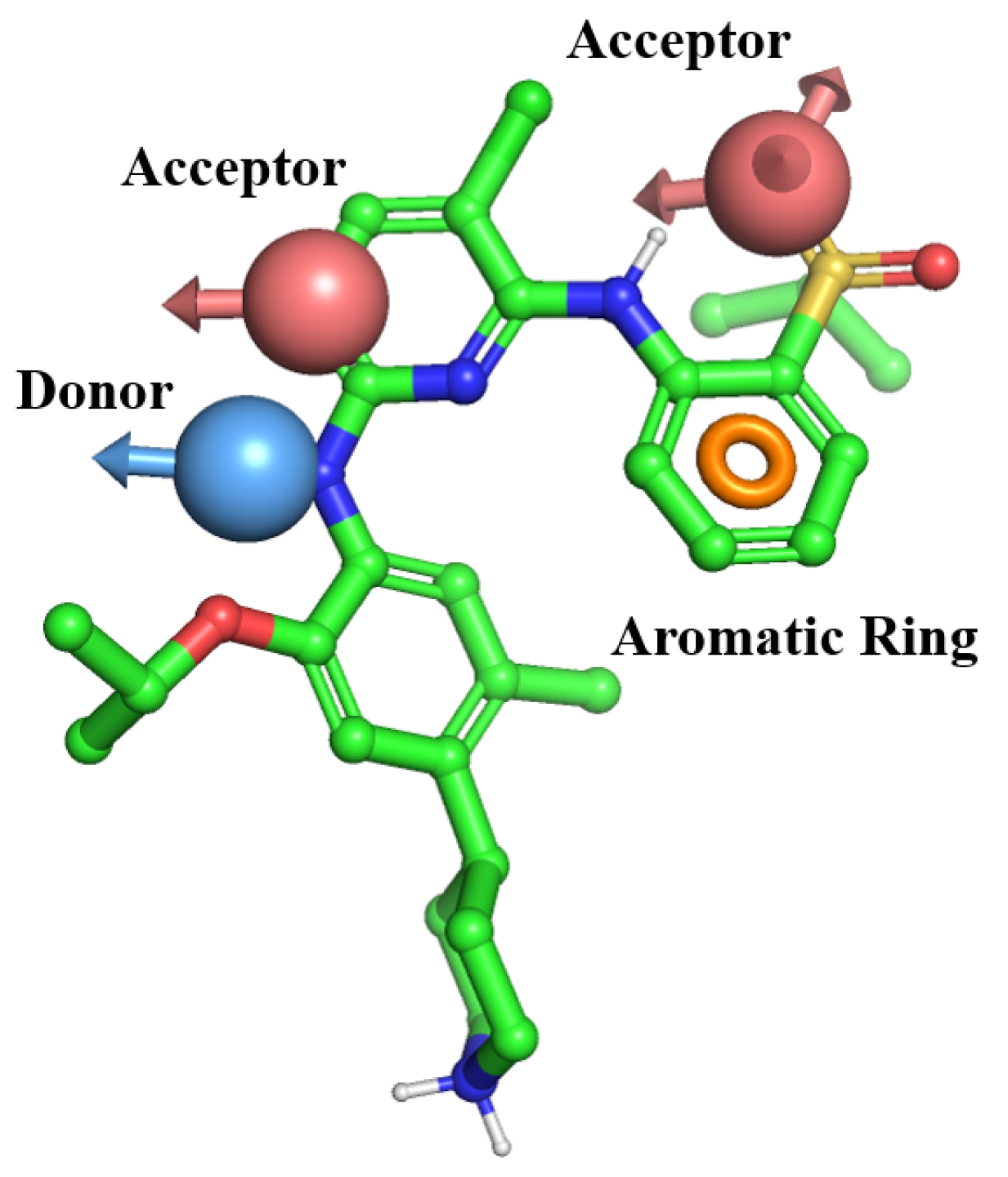
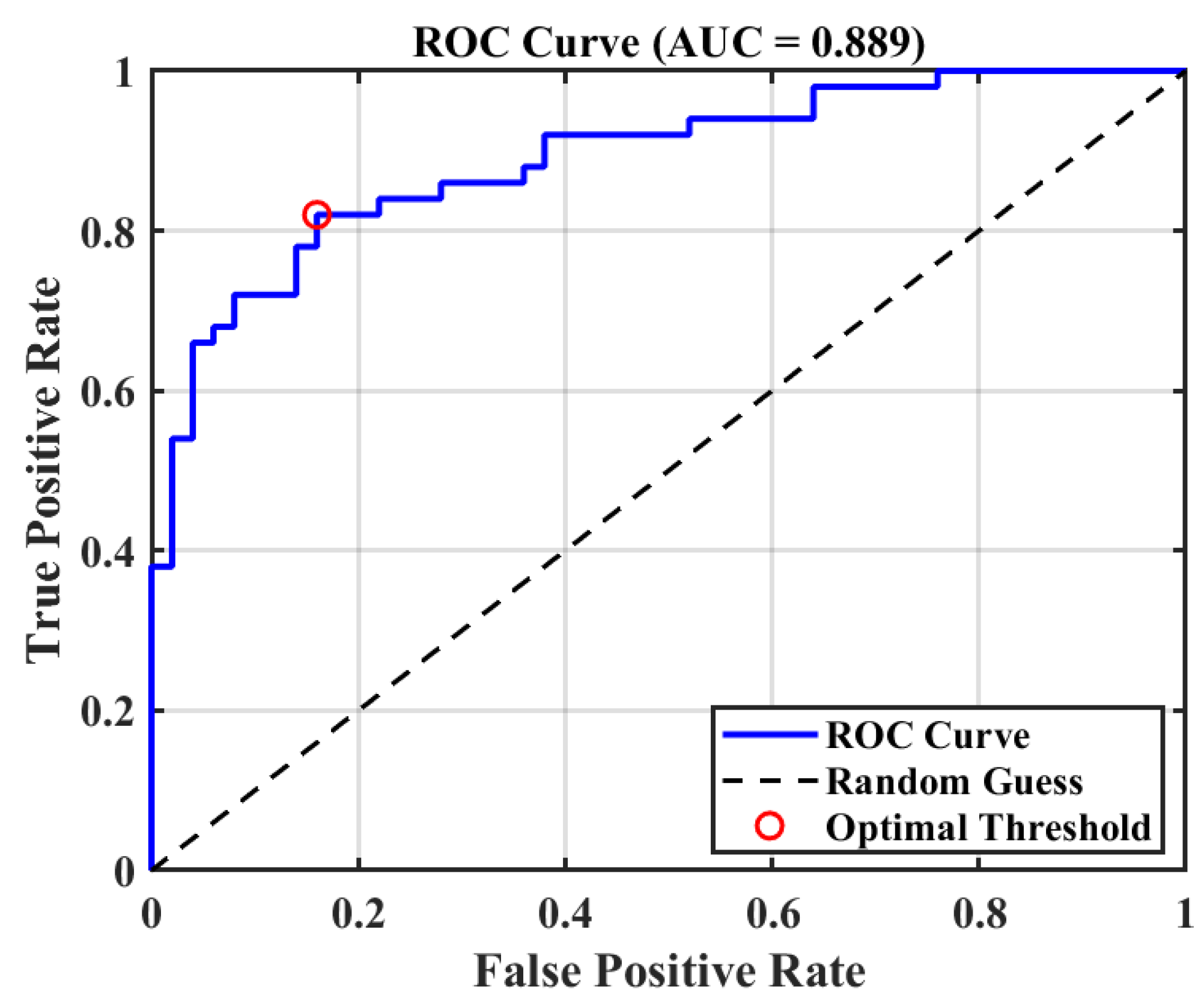
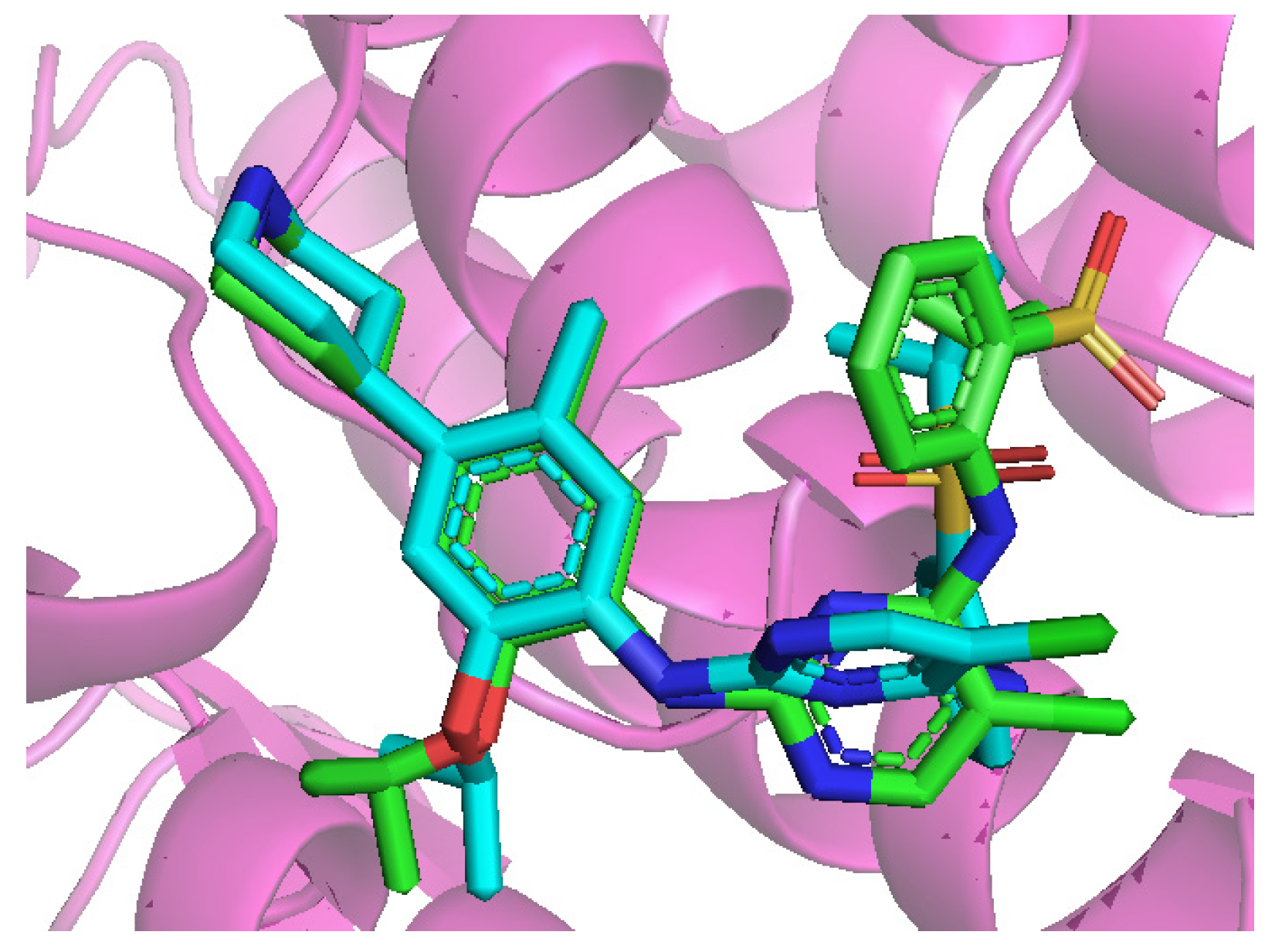

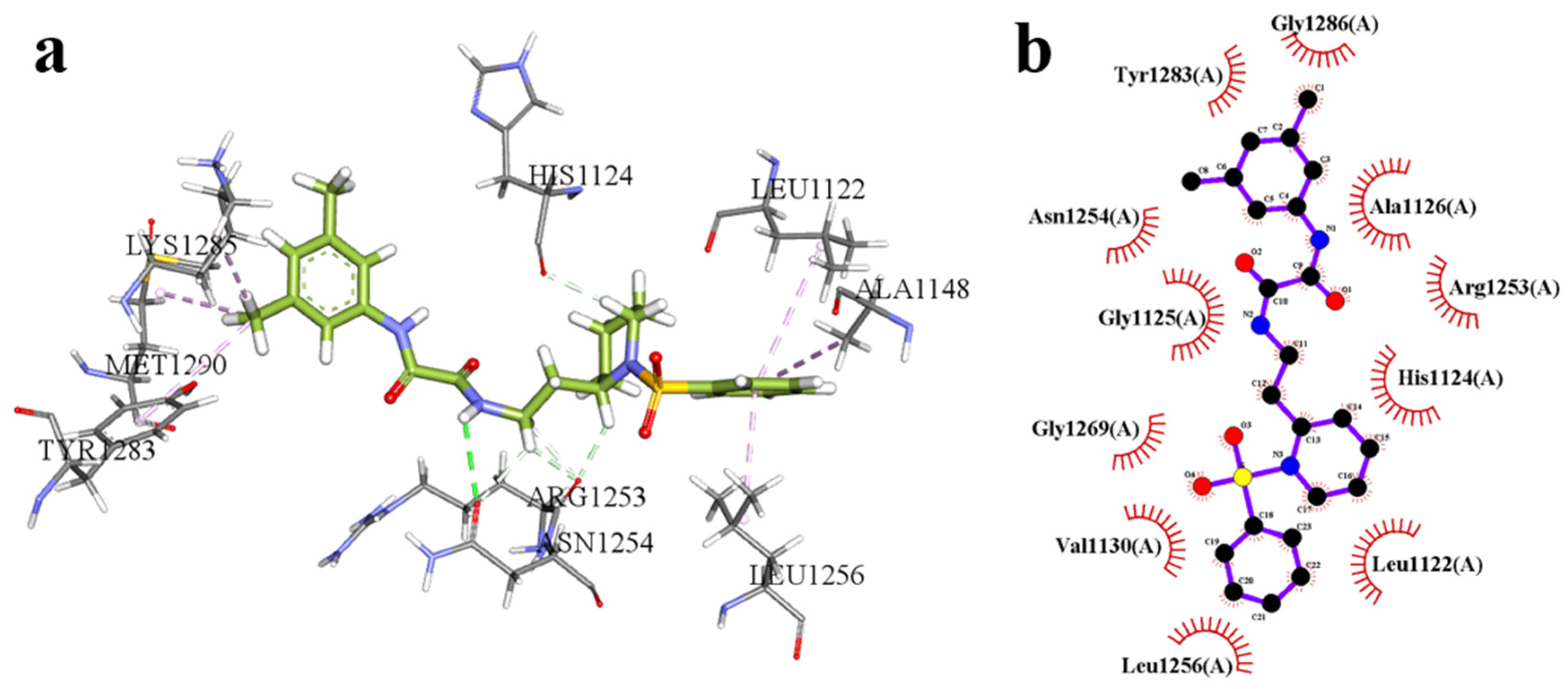
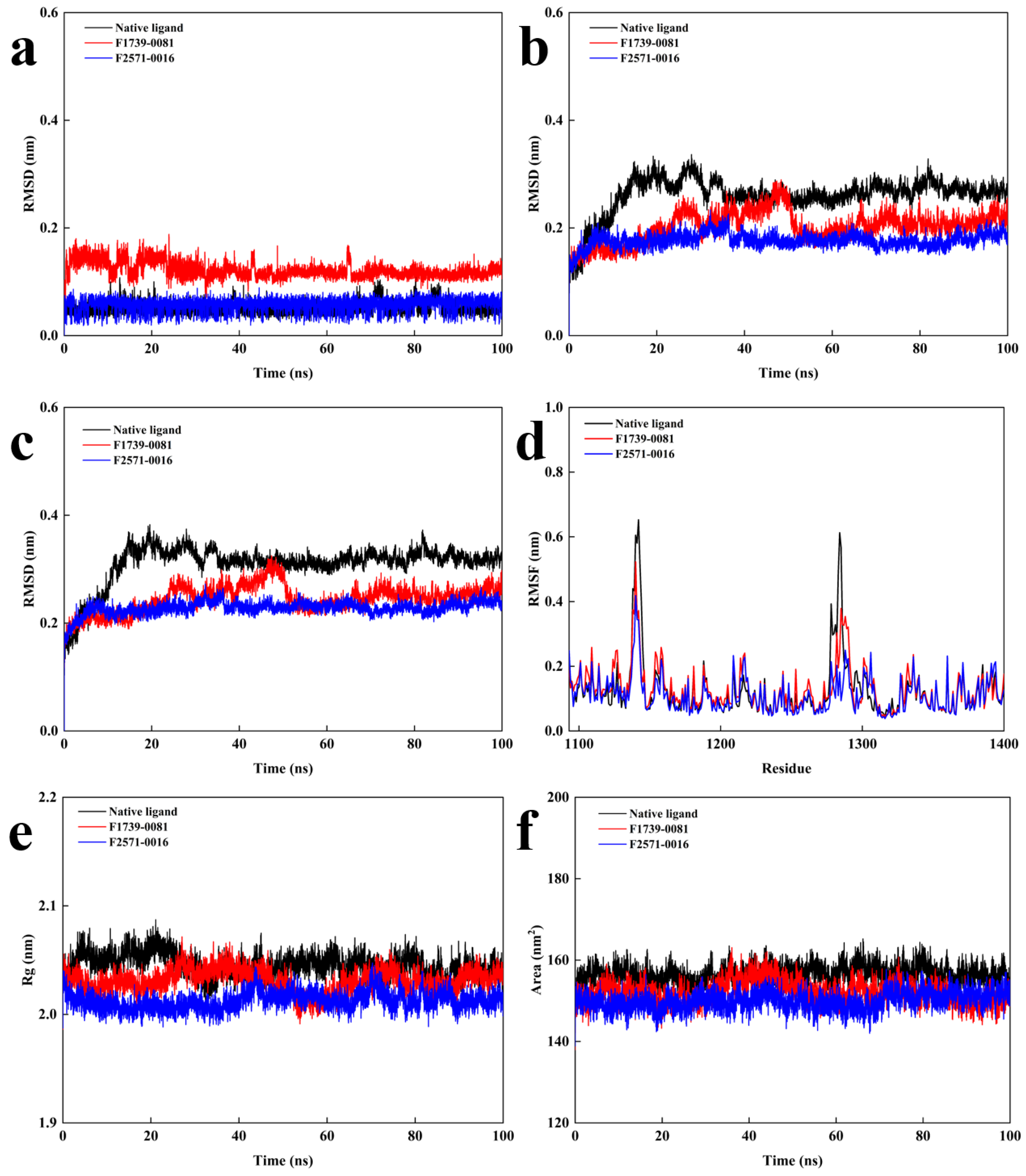
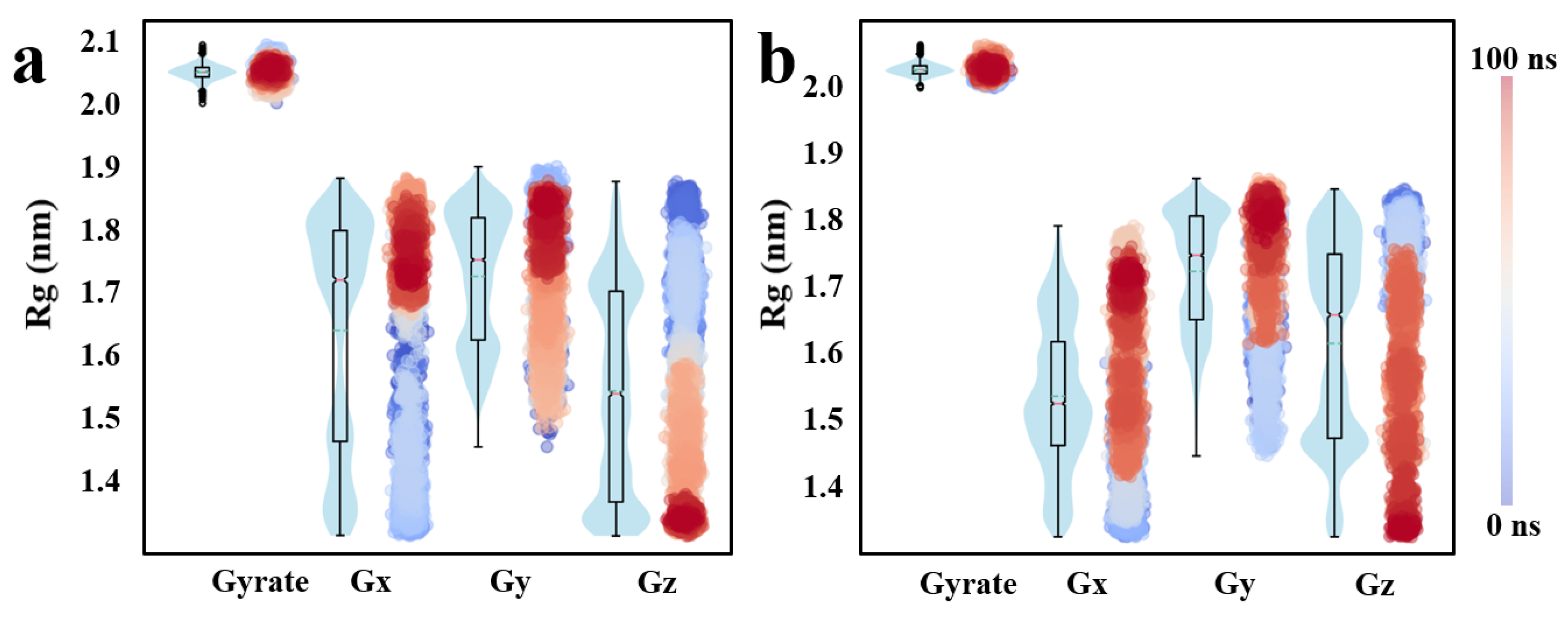
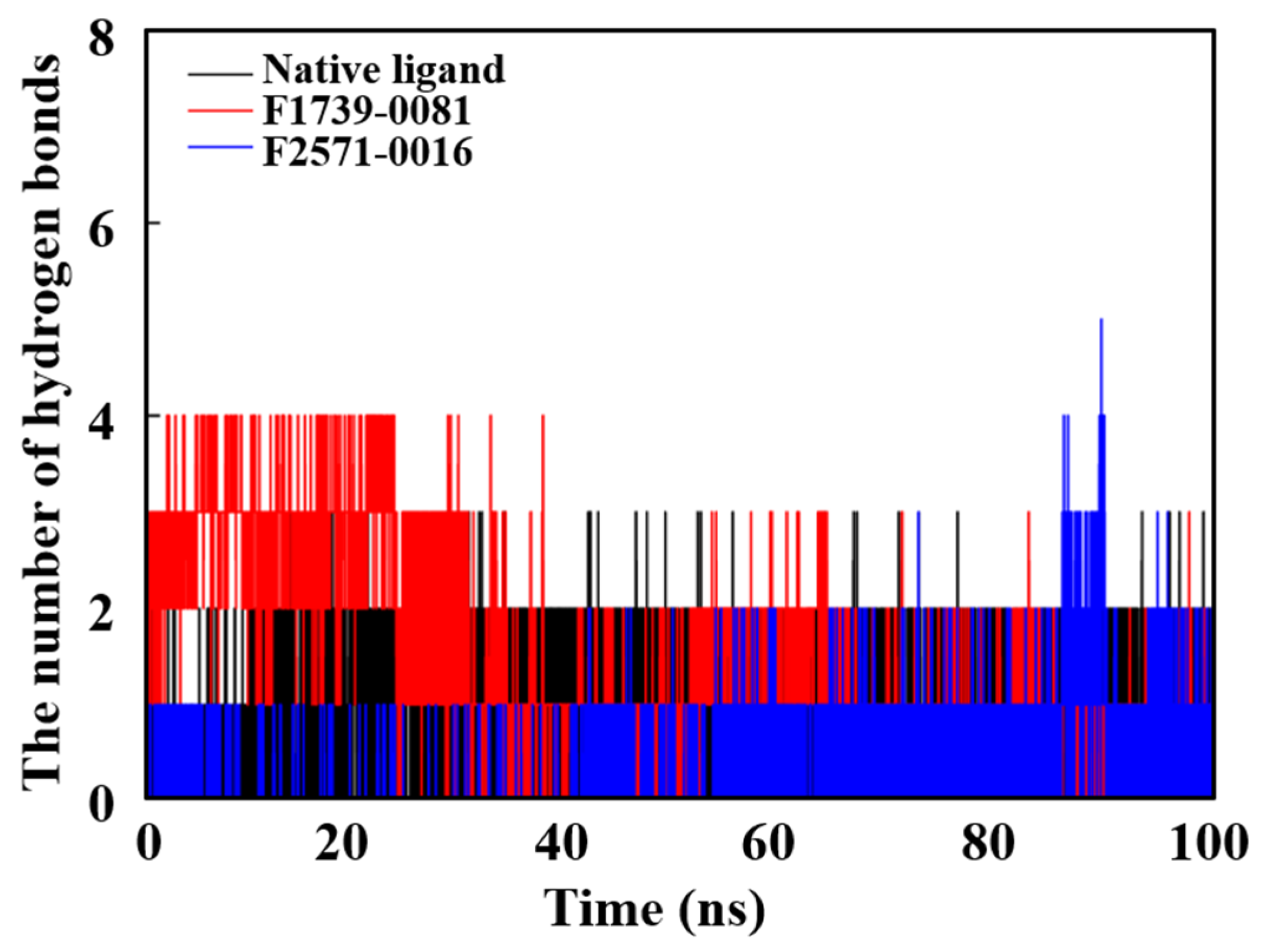

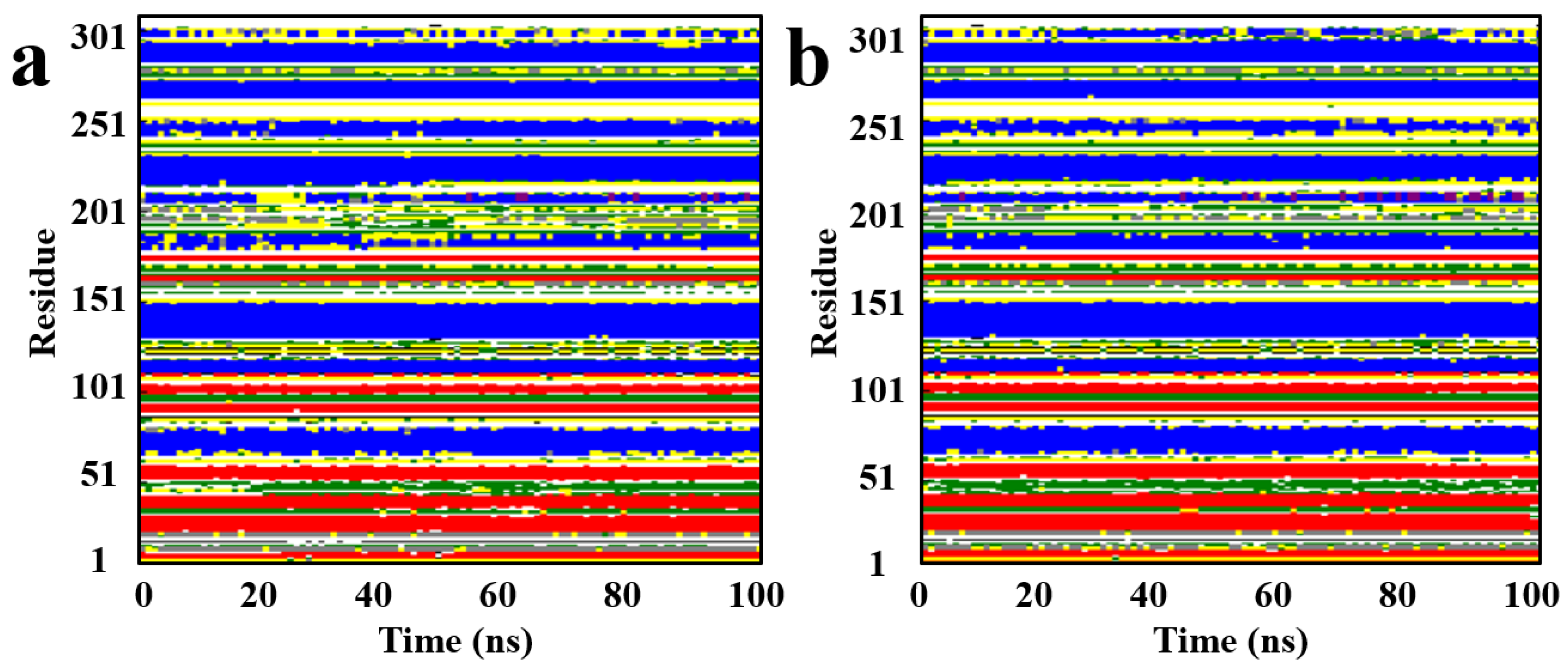

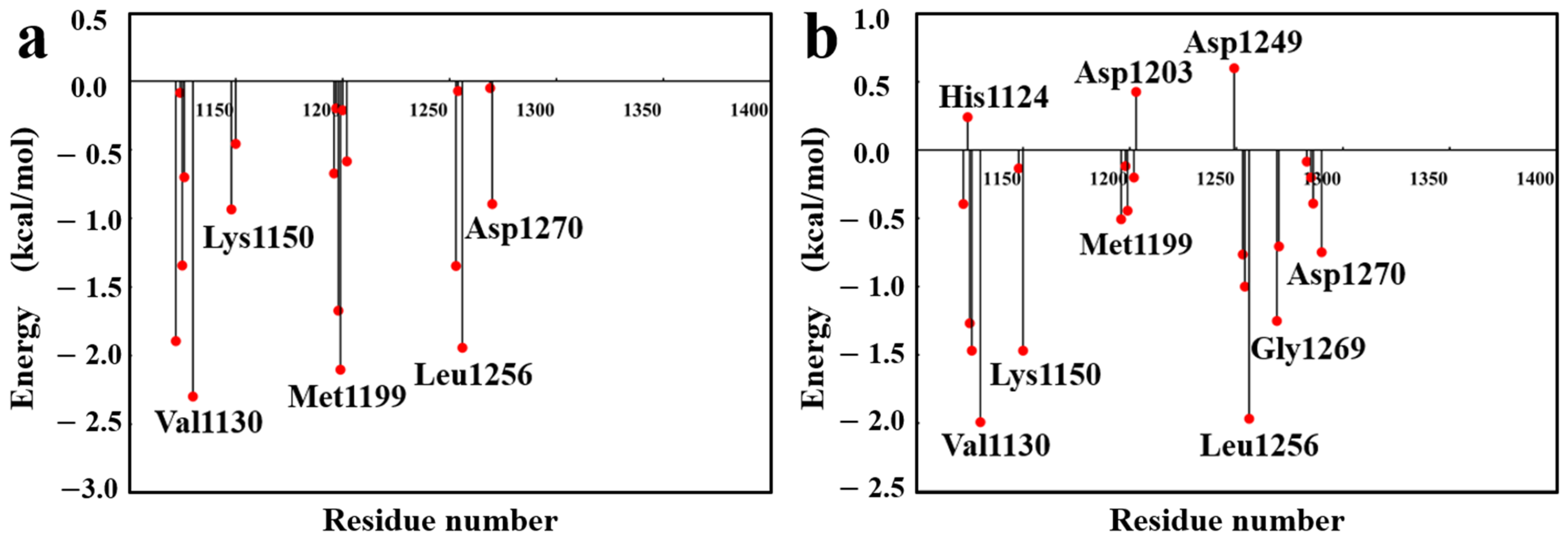
| NO | IC50 Values (μM) |
|---|---|
| A549 | |
| F1739-0081 | 261.7 |
| F2571-0016 | >500 |
| Ceritinib | 33.85 |
| Lorlatinib | 265.6 |
| Energy Component | Native Ligand (kcal/mol) | F1739-0081 (kcal/mol) | F2571-0016 (kcal/mol) |
|---|---|---|---|
| ΔEvdW | −61.25 | −52.01 | −50.50 |
| ΔEele | −29.06 | −6.80 | −15.55 |
| ΔEpolar | 50.82 | 22.36 | 37.66 |
| ΔEnonpolar | −7.56 | −6.23 | −6.87 |
| ΔGgas | −90.31 | −58.81 | −66.05 |
| ΔGsolv | 43.26 | 16.13 | 30.80 |
| ΔGMMGBSA | −47.05 | −42.68 | −35.26 |
Disclaimer/Publisher’s Note: The statements, opinions and data contained in all publications are solely those of the individual author(s) and contributor(s) and not of MDPI and/or the editor(s). MDPI and/or the editor(s) disclaim responsibility for any injury to people or property resulting from any ideas, methods, instructions or products referred to in the content. |
© 2025 by the authors. Licensee MDPI, Basel, Switzerland. This article is an open access article distributed under the terms and conditions of the Creative Commons Attribution (CC BY) license (https://creativecommons.org/licenses/by/4.0/).
Share and Cite
Zhang, Y.-K.; Tong, J.-B.; Sun, Y.; Zeng, Y.-R. Multiscale Computational and Pharmacophore-Based Screening of ALK Inhibitors with Experimental Validation. Pharmaceuticals 2025, 18, 1207. https://doi.org/10.3390/ph18081207
Zhang Y-K, Tong J-B, Sun Y, Zeng Y-R. Multiscale Computational and Pharmacophore-Based Screening of ALK Inhibitors with Experimental Validation. Pharmaceuticals. 2025; 18(8):1207. https://doi.org/10.3390/ph18081207
Chicago/Turabian StyleZhang, Ya-Kun, Jian-Bo Tong, Yue Sun, and Yan-Rong Zeng. 2025. "Multiscale Computational and Pharmacophore-Based Screening of ALK Inhibitors with Experimental Validation" Pharmaceuticals 18, no. 8: 1207. https://doi.org/10.3390/ph18081207
APA StyleZhang, Y.-K., Tong, J.-B., Sun, Y., & Zeng, Y.-R. (2025). Multiscale Computational and Pharmacophore-Based Screening of ALK Inhibitors with Experimental Validation. Pharmaceuticals, 18(8), 1207. https://doi.org/10.3390/ph18081207





